Dental instruments are essential tools used in dentistry for diagnosing and treating various oral conditions. A PDF guide with pictures and names provides a comprehensive overview, helping students and professionals identify and understand each instrument’s purpose and design, enhancing their clinical skills and knowledge.
1.1 What Are Dental Instruments?
Dental instruments are specialized tools designed for various dental procedures, including diagnosis, treatment, and patient care. They are crafted to perform specific tasks, such as examining, probing, or modifying oral tissues. These instruments are categorized into basic and specialized types, each with unique designs tailored for their intended functions. A PDF guide with pictures and names provides a detailed overview, helping users identify and understand each instrument’s purpose and characteristics. This resource is invaluable for both students and professionals in dentistry.
1.2 Importance of Dental Instruments in Dentistry
Dental instruments are essential for diagnosing and treating oral conditions, ensuring precise and efficient care. They enable dentists to perform procedures accurately, from examinations to complex surgeries. Proper instrumentation is crucial for patient safety and comfort, as it minimizes discomfort and promotes effective treatment outcomes. A PDF guide with pictures and names of dental instruments serves as a valuable resource for education, helping students and professionals master their use and application in clinical settings.
1.3 Overview of Common Dental Instruments
Common dental instruments include mirrors, probes, scalers, and curettes, each designed for specific tasks. A PDF guide with images and names offers a detailed overview, helping users understand their functions. These tools are categorized into basic and specialized types, such as drills and forceps, ensuring efficient dental care. The guide simplifies identification and use, making it an invaluable resource for both students and professionals to enhance their clinical skills and knowledge.
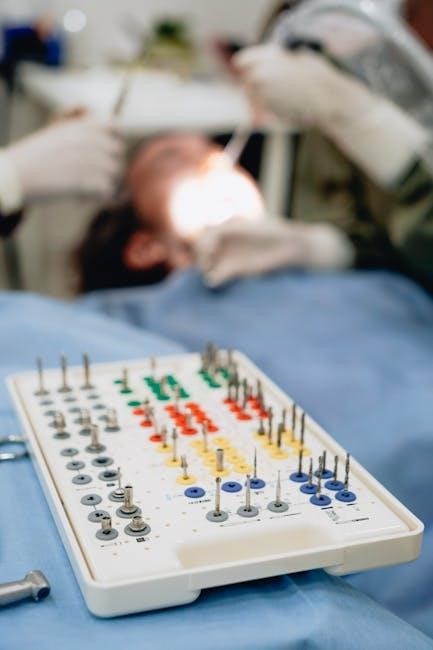
Basic Dental Instruments
Basic dental instruments are essential for routine dental procedures, aiding in examination, cleaning, and preparation. A PDF guide provides detailed names and images, ensuring easy identification.
2.1 Dental Mirror
A dental mirror is a fundamental instrument used for visualizing areas of the mouth that are difficult to see directly. It provides an indirect view, allowing dentists to examine the rear surfaces of teeth and other hard-to-reach areas. The mirror consists of a polished, reflective surface attached to a handle. There are two main types: flat mirrors for accurate images and concave mirrors for magnified views. A PDF guide with images and names helps professionals and students easily identify and understand the dental mirror’s design and functionality, enhancing their diagnostic skills and patient care.
2.2 Dental Probe
A dental probe is an essential instrument used to measure pocket depths and detect subgingival calculus. It features graduated markings, typically in millimeters, allowing for precise assessments of periodontal pockets. This tool aids in diagnosing periodontal disease and monitoring treatment progress. A PDF guide with images and names helps students and professionals identify the dental probe and understand its role in periodontal examinations, ensuring accurate and effective patient care.
2.3 Dental Explorer
A dental explorer is a handheld instrument used to detect tooth decay and irregularities on dental surfaces. Its fine, pointed tip allows for gentle probing of pits, fissures, and surfaces. A PDF guide with pictures and names helps identify the explorer and its variations, such as the 17 and 23, ensuring proper use in clinical settings. This tool is crucial for early detection of caries and monitoring restorations, making it indispensable in routine dental examinations.
2.4 Dental Scaler
A dental scaler is an essential instrument used to remove plaque, tartar, and stains from teeth, both above and below the gum line. It features a curved or angled blade with a sharp edge, designed for precise scaling. A PDF guide with pictures and names helps identify different scaler types, such as ultrasonic and hand scalers, and their specific uses. This tool is vital for maintaining oral hygiene and preventing periodontal disease, making it a cornerstone in dental cleaning procedures.
2.5 Dental Curette
A dental curette is a specialized instrument used primarily for removing plaque, tartar, and infected tissue from periodontal pockets. It features a rounded or curved blade, designed for gentle yet effective debridement. A PDF guide with pictures and names differentiates curettes by their shape and size, such as universal or area-specific designs. This tool is crucial for deep cleaning and promoting healing in periodontal therapy, ensuring precise and safe treatment in various dental procedures.

Specialized Dental Instruments
Specialized dental instruments are advanced tools designed for complex procedures, enhancing precision and efficiency. Examples include dental drills, burs, forceps, and retractors, each tailored for specific tasks. A PDF guide provides detailed names, pictures, and descriptions, helping professionals and students identify and understand these instruments, ensuring accurate use in various dental treatments.
3.1 Dental Drills and Handpieces
Dental drills and handpieces are crucial for precise and efficient dental procedures. High-speed drills are used for cavity preparation, while low-speed versions handle enamel shaping and polishing. Handpieces enhance control, reducing treatment time and improving patient comfort. A PDF guide offers detailed images and descriptions, helping professionals and students identify these tools. Understanding their functions and designs is essential for effective use in various dental treatments, ensuring optimal outcomes and patient satisfaction.
3.2 Dental Burs
Dental burs are essential attachments for drills, used to shape and remove enamel, dentin, or other materials. Available in various shapes and sizes, they cater to specific procedures like cavity preparation or implant placement. A PDF guide provides clear images and names, aiding identification and selection. Understanding bur types, such as diamond or carbide, ensures proper use, enhancing precision and efficiency in dental treatments. This resource is invaluable for both students and professionals, improving their knowledge and clinical skills.
3.3 Dental Forceps
Dental forceps are specialized instruments used primarily for extracting teeth or handling tissues. They come in various designs, each tailored for specific tooth types, such as incisors or molars. A PDF guide with detailed images and names helps in identifying forceps like the common molar forceps or root forceps. Understanding their features, such as beak shape and handle design, is crucial for effective use. This guide is a valuable resource for dental students and professionals, enhancing their ability to select the right tool for procedures, ensuring precision and patient comfort.
3.4 Dental Retractors
Dental retractors are instruments used to retract soft tissues, such as cheeks, lips, and tongues, providing clear access to the dental area. They are essential for procedures requiring visibility and precision. A PDF guide with images and names helps identify types like cheek retractors or tongue retractors. These tools vary in design, with single or double-ended options, ensuring versatility in clinical use. Understanding their proper selection and handling is crucial for effective patient care, making them a key topic in dental education and practice resources.
3.5 Dental Impression Trays
Dental impression trays are used to hold dental impression material and accurately capture the shape of a patient’s mouth. Available in stock or custom sizes, they ensure precise dental models. A PDF guide with images and names helps identify tray types, such as full, partial, or specialized trays, and their uses in various dental procedures. These trays are essential for creating accurate dental records and prosthetics, making them a critical tool in both diagnostic and restorative dentistry. Proper selection and use are emphasized in dental education and practice guides;

Dental Instruments for Specific Procedures
Dental instruments vary by procedure, including orthodontic, surgical, pediatric, and hygiene tools. A PDF guide with pictures and names helps identify instruments for specific dental tasks efficiently.
4.1 Orthodontic Instruments
Orthodontic instruments are specialized tools used to straighten and align teeth. Common tools include wire cutters, pliers, and bracket removers. A PDF guide provides detailed pictures and names, helping students and professionals recognize each instrument and understand their specific functions in orthodontic procedures. These tools are essential for adjusting braces and ensuring proper alignment, making them a cornerstone in modern orthodontic care.
4.2 Surgical Dental Instruments
Surgical dental instruments are designed for procedures like extractions, implants, and tissue manipulation. Common tools include periosteal elevators, surgical forceps, and retractors; These instruments are crucial for precise tissue retraction, bone handling, and accessing surgical sites. A PDF guide with pictures and names helps professionals identify and understand each tool’s function, ensuring effective use during complex surgeries. Proper sterilization of these instruments is essential to prevent infections and maintain patient safety.
4.3 Pediatric Dental Instruments
Pediatric dental instruments are specifically designed for treating children, ensuring comfort and safety. These tools often feature smaller sizes and blunt edges to prevent injury. Common instruments include pediatric mirrors, explorers, and probes, tailored for examining primary teeth. A PDF guide with pictures and names helps professionals and students identify these specialized tools. Bright colors and ergonomic designs make them child-friendly, reducing anxiety during procedures. Proper sterilization and organization of these instruments are crucial for effective pediatric dental care, ensuring a safe and positive experience for young patients.
4.4 Hygiene and Preventive Instruments
Hygiene and preventive dental instruments are crucial for maintaining oral health and preventing diseases. Common tools include ultrasonic scalers, polishing brushes, and fluoride applicators. These instruments are designed to remove plaque, tartar, and stains, promoting gum health. A PDF guide with pictures and names helps professionals identify and use these tools effectively. Regular use of these instruments in preventive care reduces the risk of cavities and gum disease, ensuring patients maintain a healthy smile. Proper sterilization and organization of hygiene tools are essential for effective preventive dental care.
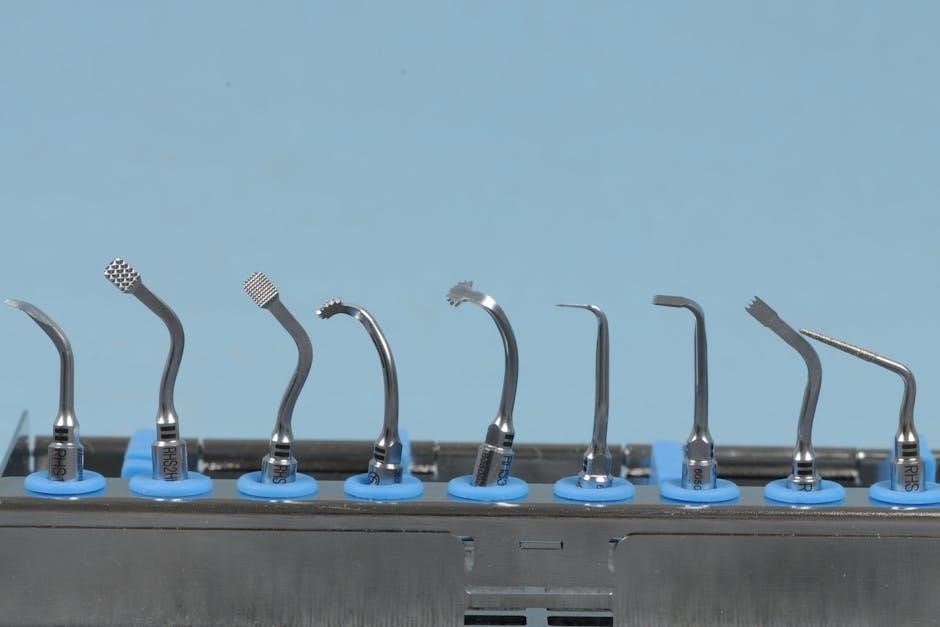
How to Identify Dental Instruments
Dental instruments can be identified by their name, function, or design. A PDF guide with pictures and names aids in easy recognition, enhancing learning and clinical efficiency.
5.1 By Name
Identifying dental instruments by their name is straightforward with a PDF guide. These guides list instruments like dental mirrors, probes, and drills, providing clear terminology. By learning their names, professionals and students can communicate effectively about specific tools, ensuring accurate usage in treatments. This method enhances understanding and standardizes terminology across dental practices, making it easier to reference instruments during procedures or studies. The PDF guide serves as a reliable resource for mastering the names of various dental tools.
5.2 By Function
Dental instruments can also be identified by their function, which is clearly outlined in a PDF guide. Instruments like mirrors are used for visibility, while probes examine surfaces, and drills perform precise procedures; The guide categorizes tools into diagnostic, restorative, and surgical functions, making it easier to understand their roles. This functional approach helps users select the right instrument for specific tasks, enhancing efficiency in dental procedures. By focusing on purpose, the guide simplifies learning and reference, ensuring instruments are used appropriately for their intended tasks.
5.3 By Design and Characteristics
Dental instruments are often identified by their unique design and characteristics, which are detailed in a PDF guide. For instance, mirrors have flat or concave surfaces, while probes feature angled tips for precise examinations. The guide highlights specific features like handle shapes, blade angles, and material types, helping users distinguish between similar tools. Understanding these physical attributes ensures proper selection and use of instruments, making the guide an invaluable resource for both learning and practical application in dental settings.
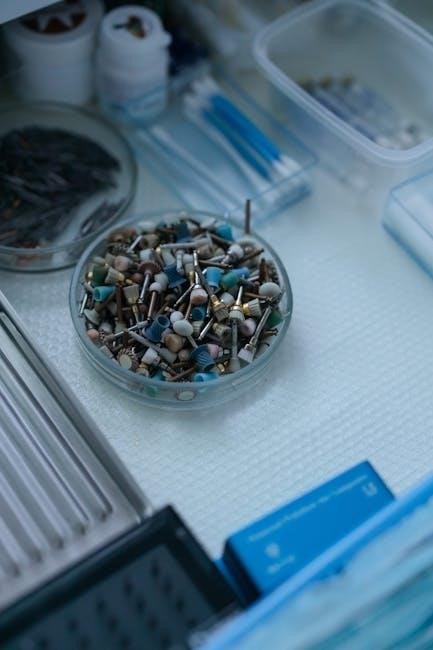
Dental Instruments Pictures and Names PDF Guide
A comprehensive PDF guide featuring dental instruments pictures and names offers an organized resource for identifying tools, enhancing learning and practice for students and professionals alike.
6.1 Why Use a PDF Guide?
A dental instruments pictures and names PDF guide is an invaluable resource for students, professionals, and patients. It provides a portable, easily accessible format for learning and reference, offering high-quality images and detailed descriptions. The guide helps in quickly identifying instruments by name, function, and design, making it an essential tool for both education and practice. Its organized structure ensures that users can effortlessly navigate through the content, enhancing their understanding of dental instrumentation.
6.2 How to Download a Free PDF Guide
Downloading a free dental instruments pictures and names PDF guide is a straightforward process. Visit reputable websites like Model Classrooms or academic platforms offering dental resources. Look for sections dedicated to dental instrumentation or educational materials. Click on the download link provided, and save the PDF to your device. Ensure the guide is comprehensive, featuring high-quality images and detailed descriptions. This resource is particularly useful for students and professionals in the UK, providing easy access to essential information on dental tools.
6.3 Key Features of a Comprehensive PDF Guide
A comprehensive dental instruments pictures and names PDF guide offers high-quality images and detailed descriptions, enabling easy identification of tools. It includes basic and specialized instruments, organized by category for quick reference. The guide features accurate naming conventions and functional explanations, ensuring clarity for students and professionals. Additional resources, such as maintenance tips and troubleshooting, enhance its utility. With clear layouts and searchable content, it serves as an invaluable resource for dental education and practice, accessible to users worldwide, including those in the UK.
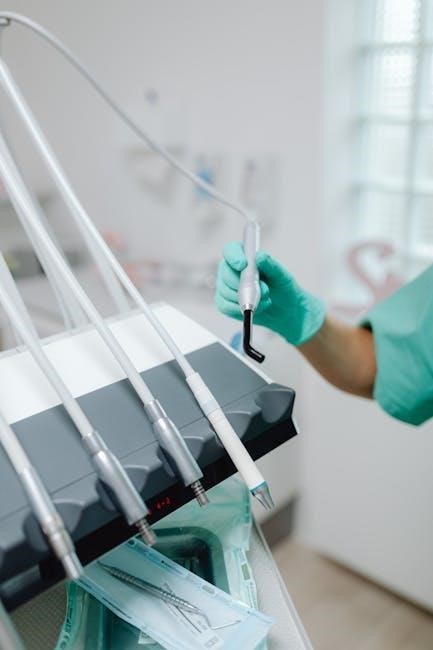
Uses of Dental Instruments PDF Guide
A dental instruments PDF guide is a valuable resource for education, offering detailed images and names of tools for students and professionals. It aids in identifying instruments, enhancing clinical skills, and serves as a quick reference for procedures. Additionally, it supports patient education by explaining the purpose of various tools, fostering transparency and trust in dental care.
7.1 For Dental Students
A dental instruments PDF guide is an invaluable tool for dental students, providing clear images and names of instruments. It aids in visual learning, helping students identify and familiarize themselves with tools used in clinical settings; The guide enhances understanding of instrument functions and proper usage, preparing students for practical training. It serves as a quick reference for studying and complements textbooks, ensuring students grasp essential knowledge effectively. This resource is crucial for building confidence and proficiency in handling dental instruments.
7.2 For Dental Professionals
A dental instruments PDF guide is a valuable resource for dental professionals, offering a quick reference for identifying tools and their uses. It enhances patient communication by providing visual aids to explain procedures. Professionals can use the guide to refresh their knowledge, train staff, and ensure consistency in instrument use. The detailed images and names support precise instrument selection, improving efficiency in clinical practice. This resource is particularly useful for specialists and general dentists aiming to maintain high standards of care and stay updated with advancements in dental instrumentation.
7.3 For Patient Education
A dental instruments PDF guide is an excellent tool for patient education, helping individuals understand the tools used in their care. Visual aids like pictures and names of instruments demystify dental procedures, reducing anxiety. Patients can preview the instruments, fostering transparency and trust. This guide is particularly useful for explaining treatments, enabling patients to make informed decisions. By sharing the guide during consultations, dentists can address concerns and ensure patients feel comfortable and informed about their care.
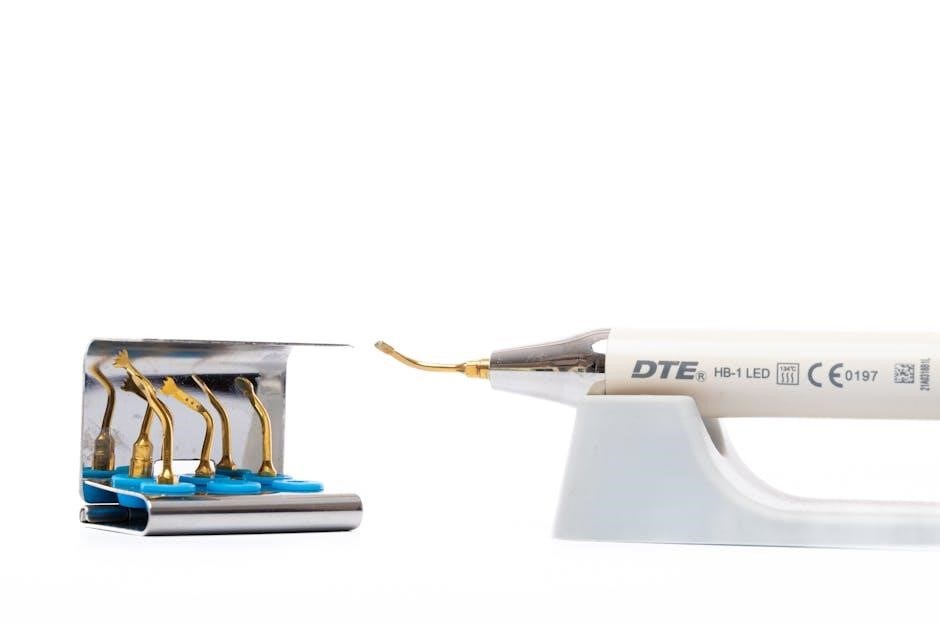
Creating Your Own Dental Instruments Guide
Creating a dental instruments guide involves selecting tools, taking high-quality images, and organizing information clearly. This resource helps users identify instruments by name, function, and design, enhancing learning and practice efficiency.
8.1 Selecting the Right Instruments
Selecting the right dental instruments for your guide involves understanding their specific uses and designs. Start by categorizing tools like mirrors, probes, and scalers, ensuring they represent common procedures. Consider their material quality, ergonomic design, and versatility across different dental specialties. Include a variety of basic and specialized instruments to cover diverse applications. Organize them by purpose, such as hygiene, operative, or surgical, to make the guide user-friendly. This curated selection will provide a clear and practical reference for learners and professionals alike.
8.2 Taking High-Quality Pictures
Taking high-quality pictures of dental instruments requires attention to detail and proper equipment; Use a macro lens for clear, detailed images. Ensure lighting is controlled to minimize reflections and shadows. Place instruments on a neutral background to avoid distractions. Consider using a reference scale for size perspective. Edit photos using software to enhance clarity and consistency. Label each instrument clearly for easy identification. These steps ensure professional-grade visuals for your guide.
8.3 Organizing the Information
Organizing information in a dental instruments guide is crucial for clarity. Categorize instruments by type, procedure, or function. Use clear headings and subheadings for easy navigation. Pair high-quality images with corresponding names, descriptions, and uses. Include a table of contents for quick reference. Use consistent formatting throughout the guide. Add indexes or cross-references for related instruments. Ensure the layout is visually appealing and user-friendly, making it accessible for both students and professionals to learn and reference effectively.
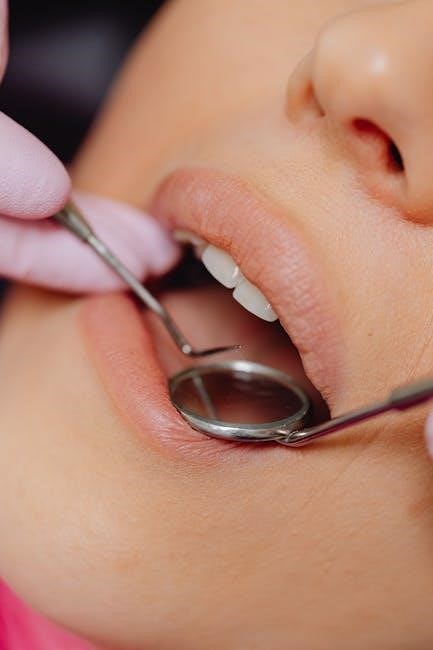
Maintenance and Sterilization of Dental Instruments
Proper cleaning and sterilization of dental instruments are essential to prevent infection and ensure patient safety. Regular maintenance prolongs their lifespan and ensures optimal performance during procedures.
9.1 Cleaning Dental Instruments
Cleaning dental instruments is a critical step before sterilization. Use enzymatic solutions like ENZYMEC to remove organic matter. Ultrasonic cleaners effectively remove debris. Always rinse thoroughly to eliminate residue. Manual scrubbing with brushes ensures intricate areas are clean. Proper cleaning prevents corrosion and ensures instruments remain functional. This step is vital for patient safety and instrument longevity, adhering to infection control standards. Regular maintenance ensures optimal performance during dental procedures.
9.2 Sterilization Methods
Sterilization of dental instruments is crucial for infection control. Common methods include autoclaving (wet heat), dry heat sterilization, and chemical vapor sterilization. Autoclaving is the most effective, using high-pressure steam to kill pathogens. Dry heat is used for heat-sensitive instruments. Chemical vapor is less common but effective for certain materials. Always follow manufacturer guidelines and ISO standards. Proper sterilization ensures patient safety and prevents cross-contamination. Regular testing of sterilization equipment is essential to maintain efficacy and reliability, ensuring all instruments are safe for use in dental procedures.
9.4 Storage and Organization
Proper storage and organization of dental instruments are vital for maintaining their functionality and longevity. Clean and dry instruments should be stored in designated trays or cases to prevent damage. Hygiene trays, operative trays, and surgical trays are designed for specific procedures, ensuring easy access. Instruments should be arranged by type and size to avoid misplacement. Regular cleaning before storage prevents corrosion and contamination. Proper organization also ensures instruments are ready for sterilization and use, reducing downtime during procedures and enhancing overall efficiency in dental practice;
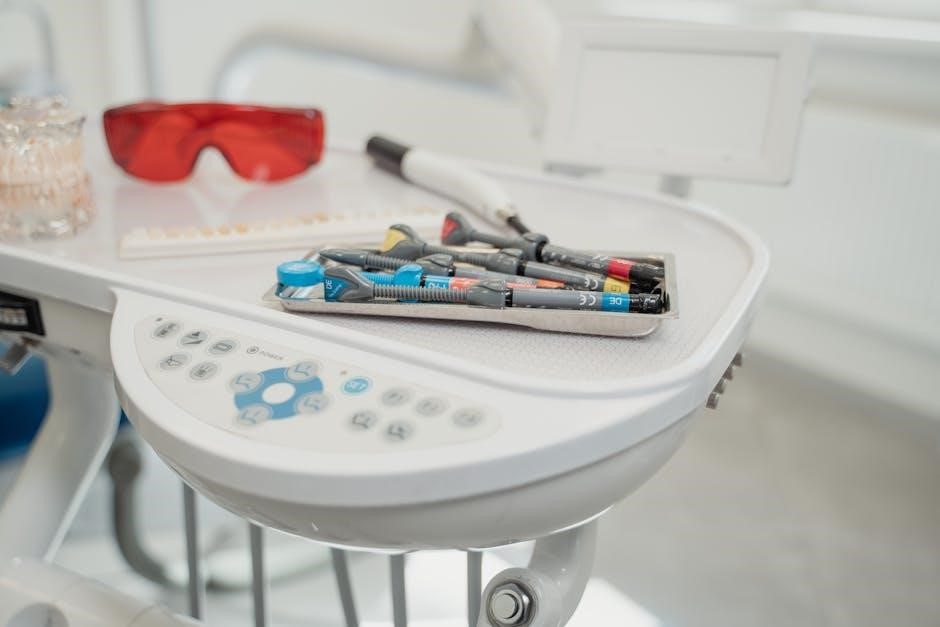
Troubleshooting Common Issues with Dental Instruments
Dental instruments can face issues like dullness or damage, requiring prompt troubleshooting. Regular maintenance and sterilization help prevent malfunctions, ensuring optimal performance during procedures.
10.1 Dull or Damaged Instruments
Dull or damaged dental instruments can hinder treatment efficiency and accuracy. Regular sharpening and inspection are crucial to maintain their effectiveness. Using a PDF guide helps identify worn tools, ensuring timely replacement or repair. Proper storage and handling also prevent damage, extending instrument lifespan. Sharp instruments are safer and reduce patient discomfort, making routine maintenance essential for optimal dental care. Neglecting this can lead to subpar outcomes, emphasizing the importance of vigilance in instrument care.
10.2 Malfunctioning Handpieces
Malfunctioning dental handpieces can disrupt procedures, causing delays and patient inconvenience. Common issues include worn gears, blocked water lines, or electrical faults. A PDF guide can help identify these problems by comparing images of damaged versus functional handpieces. Regular maintenance, such as lubrication and sterilization, is essential to prevent malfunctions. If issues persist, professional repair or replacement may be necessary to ensure optimal performance and patient safety during treatments. Early detection through visual inspection can minimize downtime and maintain efficiency in dental care.
10.3 Corroded or Rusty Instruments
Corrosion or rust on dental instruments can compromise their effectiveness and pose infection risks. Poor sterilization techniques, improper storage, or exposure to harsh chemicals often cause such damage. Regular inspection and maintenance are crucial to prevent corrosion. A PDF guide can help identify rusty instruments by comparing images of damaged tools with properly maintained ones. Proper cleaning, drying, and storage in a dry environment can extend the lifespan of instruments. Addressing corrosion early ensures patient safety and maintains the integrity of dental procedures.
Dental instruments are vital for effective dental care, and understanding their uses is essential. A PDF guide with pictures and names enhances learning, ensuring proper tool identification and application, benefiting both students and professionals in advancing their skills and patient care.
11.1 Summary of Key Points
Dental instruments play a crucial role in various dental procedures, from diagnosis to treatment. Understanding their names, functions, and designs is essential for effective patient care. A PDF guide provides a comprehensive overview, including images, to help identify and differentiate instruments. This resource is particularly valuable for dental students and professionals, offering a quick reference for learning and practice. Proper maintenance and sterilization of instruments are emphasized to ensure safety and longevity. By familiarizing oneself with these tools, dental practitioners can enhance their skills and deliver high-quality care efficiently.
11.2 Final Thoughts on Dental Instruments
Dental instruments are indispensable in modern dentistry, enabling precise diagnosis and treatment. A PDF guide with images and names simplifies learning for students and professionals, fostering confidence in instrument identification and use. Proper care and sterilization ensure longevity and patient safety. Staying updated with advancements and best practices is crucial for delivering exceptional care. Embracing these resources and maintaining high standards will continue to elevate dental care and patient outcomes.
11.3 Encouragement to Use the PDF Guide
Using a PDF guide with dental instruments’ pictures and names is a valuable resource for anyone in dentistry. It helps students and professionals quickly identify tools, enhancing learning and clinical efficiency. The guide is free, accessible, and organized, making it an indispensable asset for education and practice. Downloading it ensures you stay updated on the latest instruments and their uses, supporting continuous improvement in dental care. Embrace this resource to refine your skills and deliver exceptional patient outcomes with confidence.